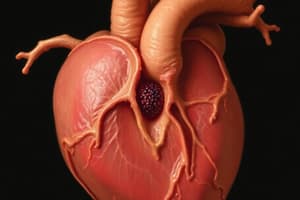Podcast
Questions and Answers
¿En qué estadio de desarrollo embrionario se forma el tubo cardíaco?
¿En qué estadio de desarrollo embrionario se forma el tubo cardíaco?
- Cinco semanas después de la concepción (correct)
- Dos semanas después de la concepción
- Un mes después de la concepción
- Ocho semanas después de la concepción
¿De qué capa de células proviene el mesodermo que contribuye a la formación del tubo cardíaco?
¿De qué capa de células proviene el mesodermo que contribuye a la formación del tubo cardíaco?
- Entodermo
- Ectodermo
- Mesodermo (correct)
- Endodermo
¿Qué forman las capas externa e interna del tubo cardíaco en desarrollo?
¿Qué forman las capas externa e interna del tubo cardíaco en desarrollo?
- Pericardio y endocardio
- Myocardio y endocardio
- Pericardio y miocardio
- Epicardio y miocardio (correct)
¿Qué regiones especializadas dan origen a los precursores cardiacos durante la morfogénesis cardíaca?
¿Qué regiones especializadas dan origen a los precursores cardiacos durante la morfogénesis cardíaca?
¿En qué especie existen regiones cardiacas distintas que contribuyen a diferentes cámaras del corazón?
¿En qué especie existen regiones cardiacas distintas que contribuyen a diferentes cámaras del corazón?
¿Qué región embrionaria contribuye al desarrollo del sistema circulatorio, incluyendo el corazón?
¿Qué región embrionaria contribuye al desarrollo del sistema circulatorio, incluyendo el corazón?
¿Cuál de los siguientes proteínas regula la especificación del compromiso con la línea cardíaca durante la morfogénesis del corazón?
¿Cuál de los siguientes proteínas regula la especificación del compromiso con la línea cardíaca durante la morfogénesis del corazón?
Durante la formación de los tractos de salida del corazón, ¿de dónde se desprende la arteria aorta?
Durante la formación de los tractos de salida del corazón, ¿de dónde se desprende la arteria aorta?
¿Qué estructura divide el bulbo cordis para formar el tabique interventricular durante la morfogénesis cardíaca?
¿Qué estructura divide el bulbo cordis para formar el tabique interventricular durante la morfogénesis cardíaca?
¿Cuál de las siguientes afirmaciones es verdadera sobre el desarrollo del corazón embrionario?
¿Cuál de las siguientes afirmaciones es verdadera sobre el desarrollo del corazón embrionario?
¿Qué evento ocurre durante la morfogénesis cardíaca para permitir la formación de las válvulas cardíacas?
¿Qué evento ocurre durante la morfogénesis cardíaca para permitir la formación de las válvulas cardíacas?
¿Cuál es la función principal de las proteínas Tbx5 y Nkx2.5 durante la morfogénesis cardíaca?
¿Cuál es la función principal de las proteínas Tbx5 y Nkx2.5 durante la morfogénesis cardíaca?
Flashcards are hidden until you start studying
Study Notes
Heart Morphogenesis
The development of the embryonic heart is a complex process, involving several stages from initial formation to the mature four-chambered structure found in adult mammals. Here, we will explore this journey through the lens of heart morphogenesis.
Early Stages: Heart Tube Formation
In the early stages of embryonic development, around five weeks into pregnancy, the heart begins to form from two layers of cells called mesoderm and endoderm. Mesoderm gives rise to three primary germ layers: somites (which contribute to skeletal muscles), splanchnic mesoderm (contributing to the gastrointestinal tract among other tissues), and lateral plate mesoderm – which becomes the source of the circulatory system, including the heart.
The heart tube forms when these layers fuse together in the midline, with the outer layer forming the epicardium and inner layer contributing to the primitive myocardium. This fusion occurs first at the ventral aspect and then extends dorsally, forming the heart tube along its entire length.
Cardiogenic Fields
Cardiac precursors arise within specialized regions called cardiogenic fields that give rise to specific parts of the heart. In mice, there are distinct anterior and posterior regions contributing to different chambers of the heart; while in humans, there are two cardiac crescent regions. These fields are marked by the presence of crucial proteins such as Nkx2.5 and Tbx5, which regulate the specification of commitment to the cardiac lineage.
Looping and Maturation of Chambers
As the heart tube grows, it undergoes looping, which causes the chambers to assume their characteristic shape. Initially, the tube loops in the craniocaudal direction, generating leftward bends and creating a 'Y' shape, with the upper chamber being the right atrium and the lower chamber becoming the left ventricle. At the same time, the outflow tracts develop from the tips of the 'Y', with the aorta budding off from the left side and the pulmonary artery from the right.
During this period, endocardial cushions appear near the junction between the atria and ventricles, eventually developing into cardiac valves. Additionally, the interatrial septum forms, dividing the right and left atria, and the bulbus cordis divides to become the interventricular septum, separating the left and right ventricles.
Concurrently, the myocardium thickens and gains contractile properties, while the coronary vasculature begins to develop. Finally, the pericardial sac envelopes the fully formed heart.
Conclusion
Heart morphogenesis is a complex process involving multiple steps and interactions between various cell types and signaling molecules. Understanding this process is crucial for studying congenital heart defects and potentially improving heart disease treatment strategies.
Studying That Suits You
Use AI to generate personalized quizzes and flashcards to suit your learning preferences.



